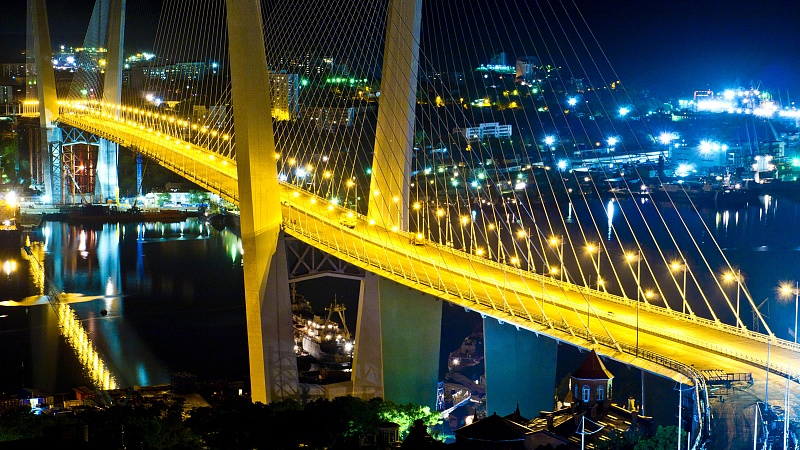Bridges of Vladivostok
For a hundred years Vladivostok residents have dreamt of a bridge; a bridge to span the narrow Golden Horn (Zolotoy Rog) Bay, which has always split the city in half. To the north there is a historic center, and a little further up is a
Before the bridge was built, the time it took to travel around Golden Horn Bay was about an hour and a half. Now it takes 5 minutes to drive from the city’s center to Churkin. The road connects an "aristocratic", upscale downtown with Churkin, a very casual,

For a hundred years Vladivostok residents have dreamt of a bridge, printing it on postcards, and picturing it in their utopian plans. Finally, in the beginning of the 21st century, the federal government asked, "Do you want a bridge? How about three bridges? The first across Golden Horn Bay, the second leading across Eastern Bosphorus strait to Russky Island (Russian Island), and the third across Amur Bay". The astonished city fell quiet in anticipation of a miracle.
All bridges needed to be built in three years, by the 2012 APEC (

Such pessimism had solid grounds: a bridge had never been built over the sea straits in Russia before, and
Still Vladivostok accepted the challenge. The bridges were designed in St. Petersburg, and we started building on our own, inviting only the French because they had the best
A

Nonetheless, they did not deviate. The soil did not sink. Tsunamis did not wash them away. A fire did not burn them down. And the skeptics found themselves buying cases of whiskey as the three bridges were built on time and already remarkably improving traffic flow throughout the city.

Today, taking a ride across all three bridges is a must for every person who visits Vladivostok. However, one has to keep in mind the notorious Vladivostok winds, especially in the winter when the wind conditions are severe. When going across the Russky (Russian) Bridge, drivers with smaller cars have to be vigilant — at times cars can be blown out of their lane!

One can also choose to walk across the Zolotoy Bridge, preferably on a calm day (at least "calm" by Vladivostok’s standards). Obviously, climbing the handrails poses a certain risk, and so there is one more thing that connects us with all major bridges — suicide jumping. Although, I must say that the bridges of Vladivostok are far behind the "records" of the Golden Gate Bridge in San Francisco.
A few facts
The bridge across Amur Bay:
4,362 meters in length (the third longest bridge in Russia).
The bridge across Zolotoy Rog Bay:
the height of the pylons is 226 meters, the distance is 737 meters, the total length is 1388 meters, and the height above water is 60 meters.
The bridge to Russky Island:
the height of the pylons is 3,254 meters (second in the world), the span length is 1,104 meters (the longest in the world at the time), the total length 3,100 meters, and the height above water is 70 meters.
If you liked this article, share it with friends:
Come to Vladivostok!
We recommend
Tourist Attractions

Old GUM Courtyard
Bread and jams in the courtyard of one of the most beautiful historic buildings in Vladivostok, where the "free port" spirit meets the creative energy of urban youth.

Vladivostok International Auto Salon
An exhibition of the latest innovations in the automotive industry, celebration of fine tuning, the awesome roar of cars and crowds, and a head-spinning "crash show" in the technical Disneyland of the Far East.

WINTER FISHING
The main winter catch in Vladivostok is smelt, which becomes a hundred times tastier if you catch it yourself.